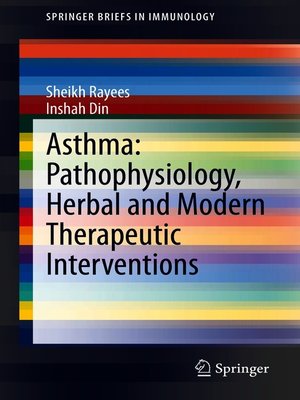Asthma
ebook ∣ Pathophysiology, Herbal and Modern Therapeutic Interventions · SpringerBriefs in Immunology
By Sheikh Rayees

Sign up to save your library
With an OverDrive account, you can save your favorite libraries for at-a-glance information about availability. Find out more about OverDrive accounts.
Find this title in Libby, the library reading app by OverDrive.



Search for a digital library with this title
Title found at these libraries:
| Library Name | Distance |
|---|---|
| Loading... |
Asthma is a chronic airway disease affecting over 300 million people worldwide with an expected increase of an additional 100 million by 2025. Past decade has observed a notable increase in asthma prevalence on both national and global levels with highest rates observed in western countries (about 30%). Over the past 40 years, a drastic increase in global prevalence, morbidity, mortality, and economic burden have been observed due to asthma especially in children. The rising numbers of hospital admissions for asthma, especially young children, reflect an increase in severe asthma, poverty and lack of proper disease management. Worldwide, approximately 180,000 deaths annually are caused due to this condition. The financial burden on a single asthma patient per year in different western countries ranges from US$300–1,300.
Asthma is an intricate respiratory disorder with differences in its severity, natural history and hence treatment response. These differences in intensities of various presentations such as bronchial hyper-responsiveness, airway inflammation, mucus production, airflow obstruction make asthma a heterogeneous disease. The mainstay of current therapies for asthma includes inhaled corticosteroids, phosphodiesterase inhibitors, leukotriene modifiers and β2-adrenoceptor agonists. Some of the currently available drugs are efficient in one or more aspects. However the associated side effects or heterogeneity of the disease limit their usefulness and efficacy, thereby putting a demand on development of new drugs and therapies. On the other hand, asthma has also been treated/managed via herbal medications. These approaches have been described in Unani, Ayurvedic or Chinese system of medicine since antiquity. In fact, several anti-asthmatic drugs were developed from herbs commonly utilized in the non-Western system of medicine.
This book focuses on the pathophysiology of asthma, its medication (both herbaland modern), limitations and their future prospects.
Asthma is an intricate respiratory disorder with differences in its severity, natural history and hence treatment response. These differences in intensities of various presentations such as bronchial hyper-responsiveness, airway inflammation, mucus production, airflow obstruction make asthma a heterogeneous disease. The mainstay of current therapies for asthma includes inhaled corticosteroids, phosphodiesterase inhibitors, leukotriene modifiers and β2-adrenoceptor agonists. Some of the currently available drugs are efficient in one or more aspects. However the associated side effects or heterogeneity of the disease limit their usefulness and efficacy, thereby putting a demand on development of new drugs and therapies. On the other hand, asthma has also been treated/managed via herbal medications. These approaches have been described in Unani, Ayurvedic or Chinese system of medicine since antiquity. In fact, several anti-asthmatic drugs were developed from herbs commonly utilized in the non-Western system of medicine.
This book focuses on the pathophysiology of asthma, its medication (both herbaland modern), limitations and their future prospects.







